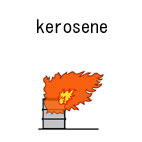| Case Name |
Fire during drain work caused by generating an insulated state on hanging a bucket on the valve of an intermediate raw material drum for hydrocarbon resin |
| Pictograph |

|
| Date |
August 9, 2000 |
| Place |
Kawasaki, Kanagawa, Japan |
| Location |
Chemical plant |
| Overview |
An operator was draining a liquid(*) into a bucket from an intermediate raw material drum where intermediate raw material of hydrocarbon resin was stored. Flames were observed in the bucket. He could not close the drain valve due to the fire. Intermediate raw material leaked through the drain nozzle, overflowed the bucket, and flowed onto the floor, and the fire spread. (*): routine work. |
| Incident |
A fire occurred during draining at an intermediate raw material drum of a hydrocarbon resin manufacturing plant. Draining was performed by suspending a bucket on the valve handle. Refer to Fig2.
Drain valve: A small valve mounted downward at a low point of piping or a vessel. It is used for drawing-off of separated water and so on. |
| Processing |
Manufacture |
| Individual Process |
Other |
| Substance |
Thermal polymerization resin |
| Kerosene |
| Type of Accident |
Fire, Leakage |
| Sequence |
About 13:45 on August 9th, 2000; drain water was being drawn off from the bottom of an intermediate raw material tank into a 20 L bucket.
About 13:49; Draining into the bucket started for the third time, and operators confirmed a change from water to oil. They tried to close the valve but failed.
About 13:50; flames were observed in the bucket.
13:52; an emergency shutdown of the plant began.
13:55; an emergency call to fire fighters was made.
13:58; the private fire brigade arrived at the site.
14:02; the public fire brigade arrived.
About 14:15; the drain valve was closed.
14:52; the fire was confirmed to have been extinguished. |
| Cause |
Ignition by static electricity was the most possible cause of a fire judged from operation conditions at the time of the accident.
Causes of static electricity generation.
1. Electrification of the drain valve and effluents from the drum.
a. The drain valve was earthed through piping and the drum, so there was a strong possibility of not being electrified.
b. The drain valve was opened by 1 turn (4 turns is full open), and the flow rate of drain was estimated to be about 4.7 m/second. It is possible that static electricity was generated in the flowing liquid.
c. The drain liquid is a non-conducting emulsion or a kerosene fraction that is easily charged.
2. Electrification of a bucket.
a. The drain in the bucket was about 5 L (emulsion layer 70%, Oil layer 30%) in total, and there was about 3 L of non-conductive material.
b. Although the receiving bucket was suspended on the drain valve, the knob was made of polyethylene resin, so there was electrical insulation.
c. Electric charge accumulated in the bucket because charged
liquid was received.
d. The voltage level in the bucket was sufficient for ignition from results of
experiments and the minimum ignition energy (0.2 mj) of the fluid. |
| Countermeasures |
1. Preventive measures for static electricity
Review of work standards
a. When there is a possibility of contamination with flammable liquid and charging with static electricity, even if it is draining water work, use of an insulated bucket is forbidden.
b. The bucket is earthed and must be made of electro conductive metallic material.
c. The factory's safety operation manual is revised.
2. Learning from similar work.
a. Objects: Sampling, draining and purging of all routine or non-routine work.
- Confirming whether the liquid is flammable and holds a static electricity charge.
- Confirming the type and the earth of the receiving vessel.
b. Providing re-training for related departments. |
| Knowledge Comment |
Accidents caused due to static electricity occur frequently. Static electricity countermeasures such as earthing are basic disaster prevention countermeasures. |
| Background |
The handle attached to the pail was covered with polyethylene, which is an isolator, and draining was done with suspending the bucket on the valve handle. The bucket might have been insulated intentionally. The first countermeasure against static electricity is to avoid such a condition. In the factory where hazardous material is handled, countermeasures for static electricity are basic safety procedures, and education is important. There seems to have been a lack of education or an imperfect safety manual. |
| Reason for Adding to DB |
A typical accident caused due to static electricity |
| Scenario |
| Primary Scenario
|
Poor Value Perception, Poor Safety Awareness, Insuficient Education/Training for Safety, Carelessness, Insufficient Understanding, Insufficient Recognition of Risk, Malicious Act, Rule Violation, Safety Rule Violation, Regular Operation, Erroneous Operation, Bad Event, Electrical Failure, Isolation, Secondary Damage, External Damage, Fire, Loss to Organization, Economic Loss, Direct Monetary Damage 50 million yen
|
|
| Sources |
Kawasaki City Fire station, Fire prevention division, Peace section. Fire when draining water from a hydrocarbon resin intermediate raw material drum, Material of the Kawasaki City Complex safety countermeasure committee (2000)
|
| Physical Damage |
Instrumentation and electric devices, a heat insulation cover of the raw material drum were damaged by fire. Intermediate raw material in total about 190 liters was destroyed by fire. |
| Financial Cost |
¥53 million. (Material of the Kawasaki City Complex safety countermeasure committee) |
| Multimedia Files |
Fig2.Sketch of the accident place
|
| Field |
Chemicals and Plants
|
| Author |
KOSEKI, Hirosi (National Research Institute of Fire and Disaster)
TAMURA, Masamitsu (Center for Risk Management and Safety Sciences, Yokohama National University)
|